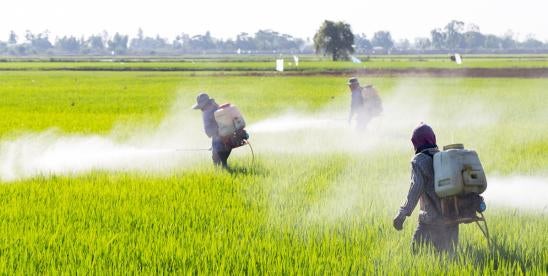Food manufacturers should pay close attention to the recent developments surrounding chlormequat chloride (chlormequat), a chemical that plaintiffs claim has been detected in various food products sold in the United States. Chlormequat is an agricultural pesticide used on oats and other food commodities. A recently published study in the science journal Nature1 reported that chlormequat was detected in the urine of 80% (77 of 96) people tested between 2016 and 2023. That study has already been cited as a basis for class action claims filed in the United States alleging certain food products are contaminated with purportedly hazardous levels of chlormequat. The study is likely to result in continued attention from the plaintiffs’ bar and may also result in additional scrutiny from regulators.
Chlormequat is a registered pesticide that is primarily used to regulate growth in ornamental plants in the United States. However, chlormequat is also used in the growing of grains such as wheat, barley, and oats.2 Since 2018, the United States has allowed residues of chlormequat on certain foods, and it has allowed imported food products with limited concentrations of chlormequat,3 including barley, eggs, poultry, and beef.4 In 2020, however, the limit specific to imported oat grain was increased from 10 to 40 parts per million (ppm).5 Until 2023, there were no domestic registrations for uses of chlormequat for food uses; however, in 2023, the Environmental Protection Agency (EPA) received its first application to use chlormequat domestically, and that application is still pending.6
Apparently in response to the increase in tolerance of chlormequat in oats, the non-profit Environmental Working Group (EWG) turned its attention to publicizing the EPA regulations and the purported potential for impact on humans from consumption, including testing various products that were purportedly found to contain chlormequat in the <0.1ppm to 0.3 ppm range. Researchers, mostly from EWG, then followed up on that with the recently published study regarding chlormequat in urine published. It is noteworthy that EWG assesses the safety data regarding chlormequat very differently from the EPA, and it regards even lower levels as unsafe. Specifically, EWG’s calculations arrive at a safe level of daily exposure equivalent to 0.05 micrograms per kilogram body weight per day, which is 1,000 times lower than EPA’s chronic reference dose of 0.05 milligrams per kilogram body weight per day. The science remains unsettled, and food makers and others likely have strong arguments that recent attention improperly implies that a hazard exists where one has not been established. As recent litigation demonstrates, however, the plaintiffs’ bar in many cases has asserted chemical contamination claims based on theories that even low levels of contamination within regulatory limits present a risk of harm, even where sound science to support such theories is lacking.
With the recent follow-up study now purporting to find detectable levels of chlormequat in humans and class action litigation challenges already being filed based on those claimed findings, food product manufacturers should be aware of the emerging developments related to chlormequat and the potential ramifications, including risk of litigation from an aggressive plaintiffs’ bar if it is detected in their products. Similarly, any company involved with the manufacture or sale of products containing chlormequat should consult with experienced counsel to monitor these developments and how they may affect their business and risk profile.
Footnotes
1 Alexis M. Temkin, Sydney Evans, Demetri D. Spyropoulos, & Olga V. Naidenko, A pilot study of chlormequat in food and urine from adults in the United States from 2017 to 2023, J. of Exposure Sci. & Env’t. Epidemiology, (2024), available at: https://www.nature.com/articles/s41370-024-00643-4?utm_medium=affiliate&utm_source=commission_junction&utm_campaign=CONR_PF018_ECOM_GL_PHSS_ALWYS_DEEPLINK&utm_content=textlink&utm_term=PID100093539&CJEVENT=aeb8d411cc3c11ee80acf6790a82b821
2 U.S. Env’t Prot. Agency, EPA Proposes to Register New Uses of Pesticide Chlormequat Chloride (last updated Apr. 26, 2023), available at: https://www.epa.gov/pesticides/epa-proposes-register-new-uses-pesticide-chlormequat-chloride.
3 83 FR 17925, Federal Register: Chlormequat Chloride; Pesticide Tolerances (Apr. 25, 2018), available at: https://www.federalregister.gov/documents/2018/04/25/2018-08695/chlormequat-chloride-pesticide-tolerances
4 40 C.F.R. § 180.698.
5 85 FR 31383, Federal Register: Chlormequat Chloride; Pesticide Tolerances (May 26, 2020), available at: https://www.federalregister.gov/documents/2020/05/26/2020-10331/chlormequat-chloride-pesticide-tolerances
6 EPA, supra note 2.





 i
i


